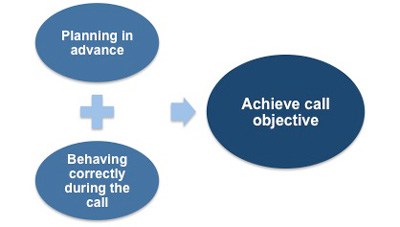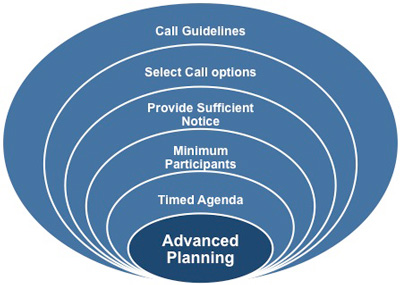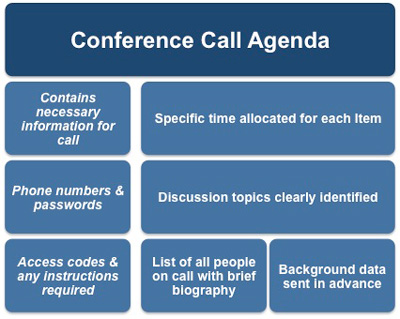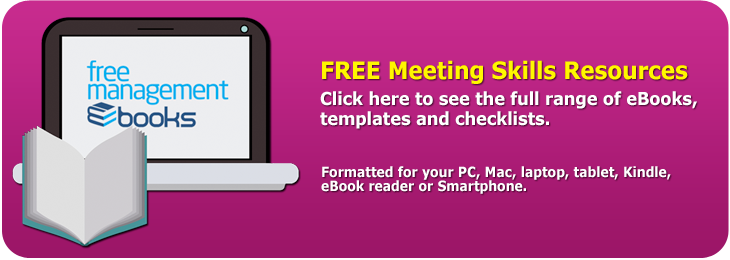Advance Planning a Conference Call
Whilst you can use the best technology available for your conference calls, this is not the only way you can improve the efficiency and productivity of such calls.
 |
You can make your conference calls more effective by taking a constructive approach to how you plan for your calls and how you conduct yourself and interact with others.
While your service provider will handle the technical aspects of the call, the real success of your teleconference is up to you. Planning and preparation is the key to your success. There are several things that you should do when planning a conference call.
Conference Call Guidelines
You should investigate whether or not your organization has such a document. These are extremely useful and every organization using this facility should have a set of published guidelines. They should cover both the technical aspects and the accepted etiquette of conference calls.
If your organization does not have such a thing then you should think about producing something yourself, even if it is only for use within your own project. Your guidelines will set other callers expectations of how they should behave and expect to be treated by other callers. It also coaches them to adopt the correct behavior during a call.
 |
Select Call Options
The technology provides you with a variety of options to choose from. Your final choice will depend on your objective for the call and the characteristics of the other callers. In this sense, you must tailor your conference call in a way that is most productive, with options such as the following: :
• Will it be dial-in or dial-out?
• Do you want it recorded?
Once again, your service provider will give you guidance in these areas. It is important to remember that for some of the options you may need to reserve your choice with the service provider. You will have to ensure your selected time and date allows sufficient lead-time for this option to be booked in advance.
Provide Sufficient Notice
Make a list of all attendees and check that they're available on the date and time planned. Obviously, the more notice you can give them, the more likely they are to be on hand for your meeting and to be properly prepared. Providing sufficient notice to those you want involved in the call greatly increases your likelihood of getting all those required to commit their time.
Then you can contact all participants giving them the date and time of the teleconference. Be mindful of time differences if it is an international call and factor this into the planning stage in order to ensure that people know the correct start time and that it is practical for everyone.
Always remember to specify the time zone so others are aware too and can quickly feedback to you if they have a problem. A simple way of avoiding any confusion is to list the different time zones of your participants so that you can quickly see reasonable times the call can effectively take place.
Keep Participants to a Minimum
A conference call with too many participants can be a frustrating experience for everyone involved. Experience suggests that calls with more than six or seven participants are too difficult to control and frequently the objective is not achieved as a result.
This in mind, you must give careful consideration to how many people you want involved and ensure that the number you decide on is sufficient to achieve your objective.
You should also make it quite clear to your participants that you want their communications to be clear and concise so that the discussions are as effective as possible. It is useful to have this clearly stated in your organization's 'conference call guidelines'.
Create an agenda
It is essential for you to retain control of the discussion as is the case with any type of gathering of minds, whether in a meeting or on a call. In the same way as you would in a meeting. you retain control through an itemized and timed agenda for your teleconference.
 |
Your agenda will ensure that you know which topics are most vital to discuss so that the call runs smoothly and on time. It also keeps participants focused on the subject at hand and helps to stop them from 'drifting off' during the discussion.
Your agenda should also include all the relevant phone numbers, passwords, access codes and clear instructions on how to dial in, even if this means stating the obvious.
You must send out any required handouts and supplementary material with sufficient time for participants to read them and prepare for the call. You should also ensure that each participant has a list of the other callers and their key information so that discussions are productive.
You should include such things as their full name and how they like to be 'known' for example 'Jon' rather than 'Jonathon', their job title, department, company and their responsibilities regarding the current project.
For example:
Jonathon Carlton - 'Jon'
HR Manager
Castleford IT Solutions LLC
Responsible for supplying the UNIX database administrators and network support staff for project 'Isis'. (NOT application programmers - see Sarah Jones below).
In your short biography you can also state what someone is not responsible for if this is thought necessary to avoid confusion or misunderstanding. Remember, if a participant is confused about the names or the responsibilities of others then this will inhibit them from making a full contribution.
When people are unsure about something as basic as another's name or responsibilities then they are more likely to say nothing rather than ask for clarification. This is especially so if they feel that this is something that they are expected to know and if they are the only person who doesn't know.
You can choose to include such introductions at the beginning of the call, but this is often confusing and a distraction in conference calls. You will have to adapt your meeting skills to suit the requirements of conference calls if you want your calls to be effective.
You may feel it appropriate to include a timed item on your agenda for feedback and questions after each item. This prevents those on the call feeling they can't ask questions due to time pressure. It is always better to schedule time after each item rather than waiting until the end of the conference and then dealing with questions on every topic that was covered.
Remember that shorter calls of 30 minutes or so will be much more effective than lengthy calls, as the longer the call is the greater opportunity there is for 'distractions' to occur and people to lose their focus. If the nature of your call means that it needs to be over 90 minutes long then it is best to schedule a ten-minute break so that people can refresh themselves. When everyone reconvenes after the break it is vital that you quickly review where you were before the break to bring everyone back up to speed.
Clarify what you can Before the Call
If you need to explain something to other participants, then send an email and accompanying documentation to each of them individually. You can then check with them, again by email or text, whether they need any further clarification.
If necessary, you can call individuals to explain specific items to ensure everyone is discussing from the same level of knowledge. This is far better than trying to do this during the call itself where it will be more difficult because of the limitations mentioned earlier. It will also make those people who don't need clarification feel as though their time is being wasted.
Assign a Minute Taker
Although everyone in the office should take his or her own notes, someone should officially record the key findings of the discussion in formal minutes. As with your meetings, you will ensure everyone on the call receives these minutes once you have checked them. This ensures that everyone has the same perceptions of what was agreed on the call and any resulting actions.
You may want to check if your teleconference service providers offer the opportunity to record the meeting into a Voicemail system. If this service is offered the minute taker can use these recordings to listen again to anything they were unsure of at the time and to double check their notes' accuracy.
You may also be interested in:An Introduction to Conference Calls, Types of Conference Call, Technical Issues Affecting Conference Calls, Human Factor Issues, Maintaining Your Productivity, Adapting Your Communication Style, Advance Planning, Controlling the Call and Conference Call Etiquette.



